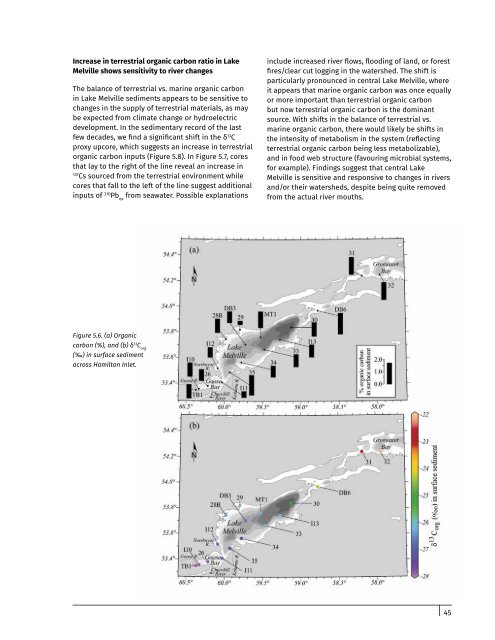Lake Melville
1rw7Mns
1rw7Mns
Create successful ePaper yourself
Turn your PDF publications into a flip-book with our unique Google optimized e-Paper software.
Increase in terrestrial organic carbon ratio in <strong>Lake</strong><br />
<strong>Melville</strong> shows sensitivity to river changes<br />
The balance of terrestrial vs. marine organic carbon<br />
in <strong>Lake</strong> <strong>Melville</strong> sediments appears to be sensitive to<br />
changes in the supply of terrestrial materials, as may<br />
be expected from climate change or hydroelectric<br />
development. In the sedimentary record of the last<br />
few decades, we find a significant shift in the δ 13 C<br />
proxy upcore, which suggests an increase in terrestrial<br />
organic carbon inputs (Figure 5.8). In Figure 5.7, cores<br />
that lay to the right of the line reveal an increase in<br />
137<br />
Cs sourced from the terrestrial environment while<br />
cores that fall to the left of the line suggest additional<br />
inputs of 210 Pb ex<br />
from seawater. Possible explanations<br />
include increased river flows, flooding of land, or forest<br />
fires/clear cut logging in the watershed. The shift is<br />
particularly pronounced in central <strong>Lake</strong> <strong>Melville</strong>, where<br />
it appears that marine organic carbon was once equally<br />
or more important than terrestrial organic carbon<br />
but now terrestrial organic carbon is the dominant<br />
source. With shifts in the balance of terrestrial vs.<br />
marine organic carbon, there would likely be shifts in<br />
the intensity of metabolism in the system (reflecting<br />
terrestrial organic carbon being less metabolizable),<br />
and in food web structure (favouring microbial systems,<br />
for example). Findings suggest that central <strong>Lake</strong><br />
<strong>Melville</strong> is sensitive and responsive to changes in rivers<br />
and/or their watersheds, despite being quite removed<br />
from the actual river mouths.<br />
Figure 5.6. (a) Organic<br />
carbon (%), and (b) δ 13 C org<br />
(‰) in surface sediment<br />
across Hamilton Inlet.<br />
45


